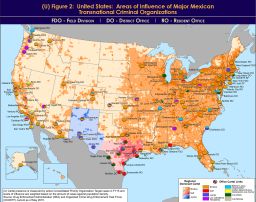Story highlights
El Chapo's absence presents new landscape for drug cartels
The rival cartel allegedly behind the kidnapping of El Chapo's son is flexing its muscle
As Joaquin “El Chapo” Guzman awaits extradition to the United States, he leaves behind what appears to be a new landscape for Mexico’s drug cartels.
Last week, his son, Jesus Alfredo Guzman, was kidnapped by men authorities believe were members of a rival cartel. Sources tell CNN he was released Saturday, but his abduction signals that the game of thrones for Mexico’s next top drug cartel has already begun.
Here’s what you need to know about the power vacuum and the key players:
Sinaloa’s power structure
Jesus Alfredo Guzman, who was kidnapped August 15, was allegedly groomed to take the reins of the Sinaloa cartel his father ran – except he’s got a bit of a party-boy reputation. A senior Mexican law enforcement told CNN, “(The kidnapping) is an important development because it affects the power structure of the Sinaloa cartel. (El Chapo’s) son was supposed to be part of the new leadership,” alleging that he wasn’t taking the role seriously. While the kidnapping doesn’t dismantle the Sinaloa cartel, it was considered a blow to the existing power structure.
Turf war: Sinaloa Federation vs. Jalisco New Generation?

Jalisco New Generation, the group allegedly responsible for the kidnapping, is one of the fastest growing cartels and has been actively fighting to gain control of Sinaloa territory in Tijuana and Baja California, according to the Los Angeles Times. A report by the State Department noted a “consistent increase of activity involving rival cartels, specifically Cartel Jalisco Nueva Generacion in Baja California.” Jalisco New Generation first began in 2011 as the armed unit within the Sinaloa cartel, allegedly murdering 35 Zetas members.
Attacks becoming more personal

Since El Chapo’s second capture, rival cartels have directly targeted family members who previously would have been off-limits. Earlier this summer, 150 assailants ransacked the home of Guzman’s 86-year-old mother in the family’s hometown of La Tuna, The Guardian reported. While his mother wasn’t harmed, three people reportedly died in the attack. “I can’t imagine anyone doing this while he was active,” biographer Malcolm Beith told The Guardian. According to NPR, two nephews on his wife’s side were also allegedly killed in a separate incident this summer.
Violence could get worse
Eighty thousand people were killed at the height of the drug wars between 2006 and 2015, the Congressional Research Service (CRS) found. While the government no longer collects data on deaths related specifically to organized crime, “the rate of all homicides in Mexico has declined by 30 percent” between 2012 to 2015, according to a report by the CRS. But a 30% drop in the murder rate does not mean violence has stopped. Journalists are still missing, local business owners are still threatened, extortion still occurs. Analysts say the power vacuum could lead to more chaos as stability weakens.
In April, the US State Department issued a travel warning cautioning Americans in Baja California to be careful. “Tijuana and Rosarito continued to experience an increase in homicide rates from January to October 2015 compared to the same period in the previous year,” the warning said, citing the Baja State Secretariat for Public Security. Many of these killings appear to be “targeted criminal organization assassinations,” but the State Department warned also of “turf battles” that could break out in areas frequented by US citizens.
The fight for territory and power.
Although power dynamics among cartels are always shifting, the US Drug Enforcement Administration names six other major cartels, not including Sinaloa, that were powerful in recent years as of July 2015: Los Zetas, Tijuana/AFO, Juárez/CFO, Beltrán Leyva, Gulf, and La Familia Michoacana. According to the DEA, these groups alone are likely to have splintered off into nine or as many as 20 other groups.
What about drug trade into US?

Click here for full image.
The trafficking of heroin, marijuana, cocaine and meth into the United States from Mexico is an annual $19 to 20 billion industry, according to a Department of Homeland Security report. And the Sinaloa cartel has traditionally held a dominant share of that, thanks to Guzman’s sophisticated business strategies and Sinaloa’s control of trafficking routes. But even if the head of the snake is removed, the drugs continue to flow. A Customs and Border Protection report that analyzed seizure data along the border between 2009 and 2010 found that “the removal of key personnel does not have a discernable impact on drug flows” into the US.
Even El Chapo is aware that drug trafficking won’t end once he’s gone. “The day I don’t exist, it’s not going to decrease in any way at all,” he told Sean Penn in an interview recorded during his last escape from prison.


